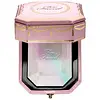What's inside
What's inside
 Key Ingredients
Key Ingredients

 Benefits
Benefits

 Concerns
Concerns

 Ingredients Side-by-side
Ingredients Side-by-side

Mica
Cosmetic ColorantCalcium Aluminum Borosilicate
Dimethicone
EmollientSynthetic Fluorphlogopite
Hdi/Trimethylol Hexyllactone Crosspolymer
Boron Nitride
AbsorbentPEG-12 Dimethicone
Skin ConditioningVinyl Dimethicone/Methicone Silsesquioxane Crosspolymer
Caprylyl Glycol
EmollientPotassium Chloride
Ethylhexylglycerin
Skin ConditioningCaesalpinia Sappan Bark Extract
Skin ConditioningChlorphenesin
AntimicrobialTin Oxide
AbrasiveWater
Skin ConditioningChondrus Crispus
MaskingOctyldodecyl Stearoyl Stearate
EmollientTocopheryl Acetate
AntioxidantTriethoxycaprylylsilane
Silica
AbrasiveGellan Gum
Tocopherol
AntioxidantCI 77891
Cosmetic ColorantCI 77491
Cosmetic ColorantMica, Calcium Aluminum Borosilicate, Dimethicone, Synthetic Fluorphlogopite, Hdi/Trimethylol Hexyllactone Crosspolymer, Boron Nitride, PEG-12 Dimethicone, Vinyl Dimethicone/Methicone Silsesquioxane Crosspolymer, Caprylyl Glycol, Potassium Chloride, Ethylhexylglycerin, Caesalpinia Sappan Bark Extract, Chlorphenesin, Tin Oxide, Water, Chondrus Crispus, Octyldodecyl Stearoyl Stearate, Tocopheryl Acetate, Triethoxycaprylylsilane, Silica, Gellan Gum, Tocopherol, CI 77891, CI 77491
Mica
Cosmetic ColorantCetearyl Ethylhexanoate
EmollientHdi/Trimethylol Hexyllactone Crosspolymer
Squalane
EmollientOctyldodecyl Stearoyl Stearate
EmollientGlycerin
HumectantSynthetic Fluorphlogopite
Alumina
AbrasivePolysorbate 20
EmulsifyingCaprylyl Glycol
EmollientEthylhexylglycerin
Skin ConditioningSilica
Abrasive1,2-Hexanediol
Skin ConditioningXanthan Gum
EmulsifyingChondrus Crispus
MaskingPentaerythrityl Tetraoleate
EmollientMethyl Di-T-Butyl Hydroxyhydrocinnamate
AntioxidantDicalcium Phosphate
AbrasiveBenzimidazole Diamond Amidoethyl Urea Carbamoyl Propyl Polymethylsilsesquioxane
Cosmetic ColorantTin Oxide
AbrasiveCI 75470
Cosmetic ColorantTitanium Dioxide
Cosmetic ColorantIron Oxides
CI 77510
Cosmetic ColorantCI 77288
Cosmetic ColorantCI 77007
Cosmetic ColorantCI 77742
Cosmetic ColorantCI 19140
Cosmetic ColorantCI 15985
Cosmetic ColorantCI 42090
Cosmetic ColorantCI 15850
Cosmetic ColorantCI 73360
Cosmetic ColorantMica, Cetearyl Ethylhexanoate, Hdi/Trimethylol Hexyllactone Crosspolymer, Squalane, Octyldodecyl Stearoyl Stearate, Glycerin, Synthetic Fluorphlogopite, Alumina, Polysorbate 20, Caprylyl Glycol, Ethylhexylglycerin, Silica, 1,2-Hexanediol, Xanthan Gum, Chondrus Crispus, Pentaerythrityl Tetraoleate, Methyl Di-T-Butyl Hydroxyhydrocinnamate, Dicalcium Phosphate, Benzimidazole Diamond Amidoethyl Urea Carbamoyl Propyl Polymethylsilsesquioxane, Tin Oxide, CI 75470, Titanium Dioxide, Iron Oxides, CI 77510, CI 77288, CI 77007, CI 77742, CI 19140, CI 15985, CI 42090, CI 15850, CI 73360
Ingredients Explained
These ingredients are found in both products.
Ingredients higher up in an ingredient list are typically present in a larger amount.
Caprylyl Glycol is a humectant and emollient, meaning it attracts and preserves moisture.
It is a common ingredient in many products, especially those designed to hydrate skin. The primary benefits are retaining moisture, skin softening, and promoting a healthy skin barrier.
Though Caprylyl Glycol is an alcohol derived from fatty acids, it is not the kind that can dry out skin.
This ingredient is also used as a preservative to extend the life of products. It has slight antimicrobial properties.
Learn more about Caprylyl GlycolChondrus Crispus is a red algae native to the northern Atlantic ocean.
It is rich in antioxidants. The polysaccharides, peptides, and amino acid content helps moisturize skin.
Antioxidants present in chondrus crispus include lutein and zeaxanthin. Lutein has the ability to filter blue light from screens.
Learn more about Chondrus CrispusEthylhexylglycerin (we can't pronounce this either) is commonly used as a preservative and skin softener. It is derived from glyceryl.
You might see Ethylhexylglycerin often paired with other preservatives such as phenoxyethanol. Ethylhexylglycerin has been found to increase the effectiveness of these other preservatives.
This ingredient is a powder used to improve texture, slip, and give products a silky texture.
Mica is a naturally occurring mineral used to add shimmer and color in cosmetics. It can also help improve the texture of a product or give it an opaque, white/silver color.
Serecite is the name for very fine but ragged grains of mica.
This ingredient is often coated with metal oxides like titanium dioxide. Trace amounts of heavy metals may be found in mica, but these metals are not harmful in our personal products.
Mica has been used since prehistoric times throughout the world. Ancient Egyptian, Indian, Greek, Roman, Aztec, and Chinese civilizations have used mica.
Learn more about MicaOctyldodecyl Stearoyl Stearate is created from stearic acid.
It is an emollient and thickens the lipid (oil) portion of a product. Due to its emollient properties, it may not be fungal-acne safe.
Silica, also known as silicon dioxide, is a naturally occurring mineral. It is used as a fine, spherical, and porous powder in cosmetics.
Though it has exfoliant properties, the function of silica varies depending on the product.
The unique structure of silica enhances the spreadability and adds smoothness, making it a great texture enhancer.
It is also used as an active carrier, emulsifier, and mattifier due to its ability to absorb excess oil.
In some products, tiny microneedles called spicules are made from silica or hydrolyzed sponge. When you rub them in, they lightly polish away dead skin layers and enhance the penetration of active ingredients.
Learn more about SilicaSynthetic Fluorphlogopite is the synthethic version of mica. It consists of fluorine, aluminum and silicate.
Synthetic Fluorphlogopite is used to add volume to products.
It is considered non-irritating on the skin.
Learn more about Synthetic FluorphlogopiteTin Oxide is an inorganic oxide used to add opacity and volume to a product. In nature, it is already found in mineral form. The main ore of tin is an opaque and shiny mineral called casseterite.
Tin Oxide helps remove translucency in a product, or make it more opaque. Besides adding opacity, tin oxide is used for bulking to add volume.